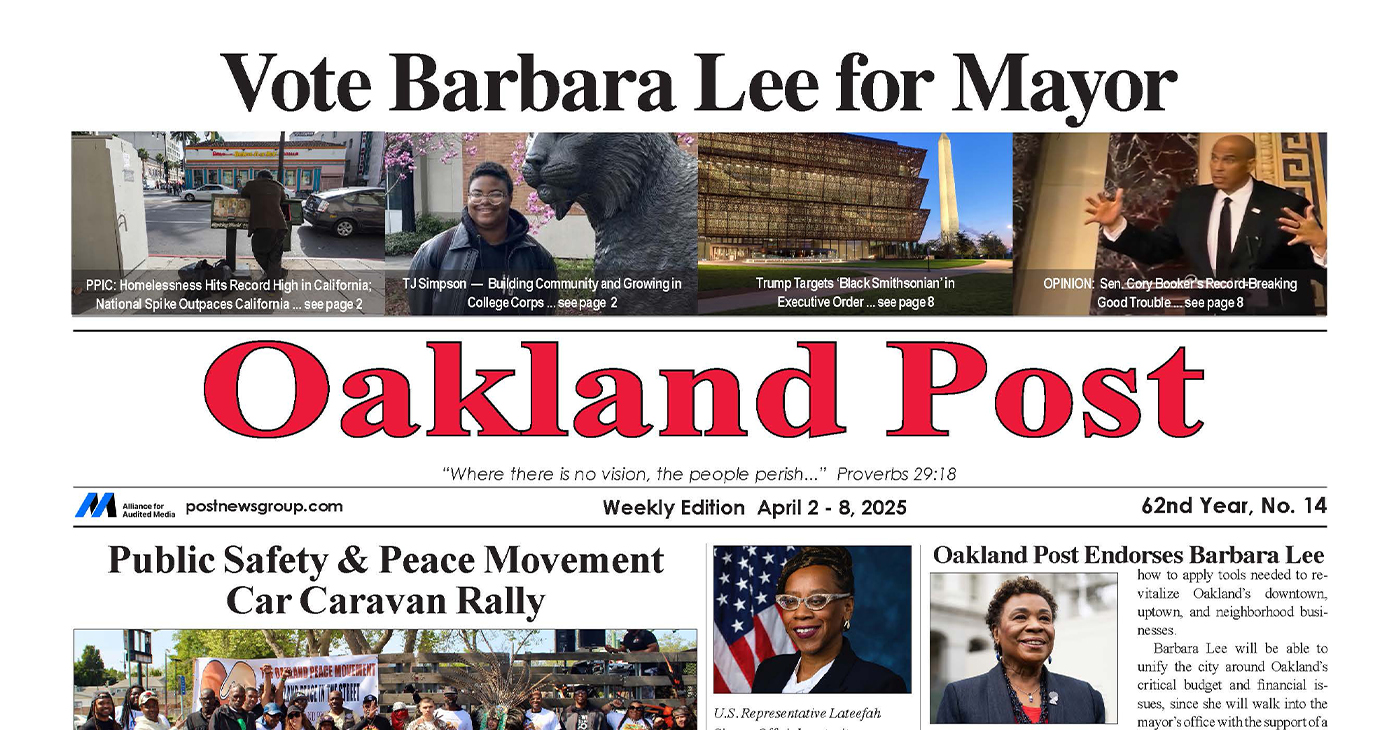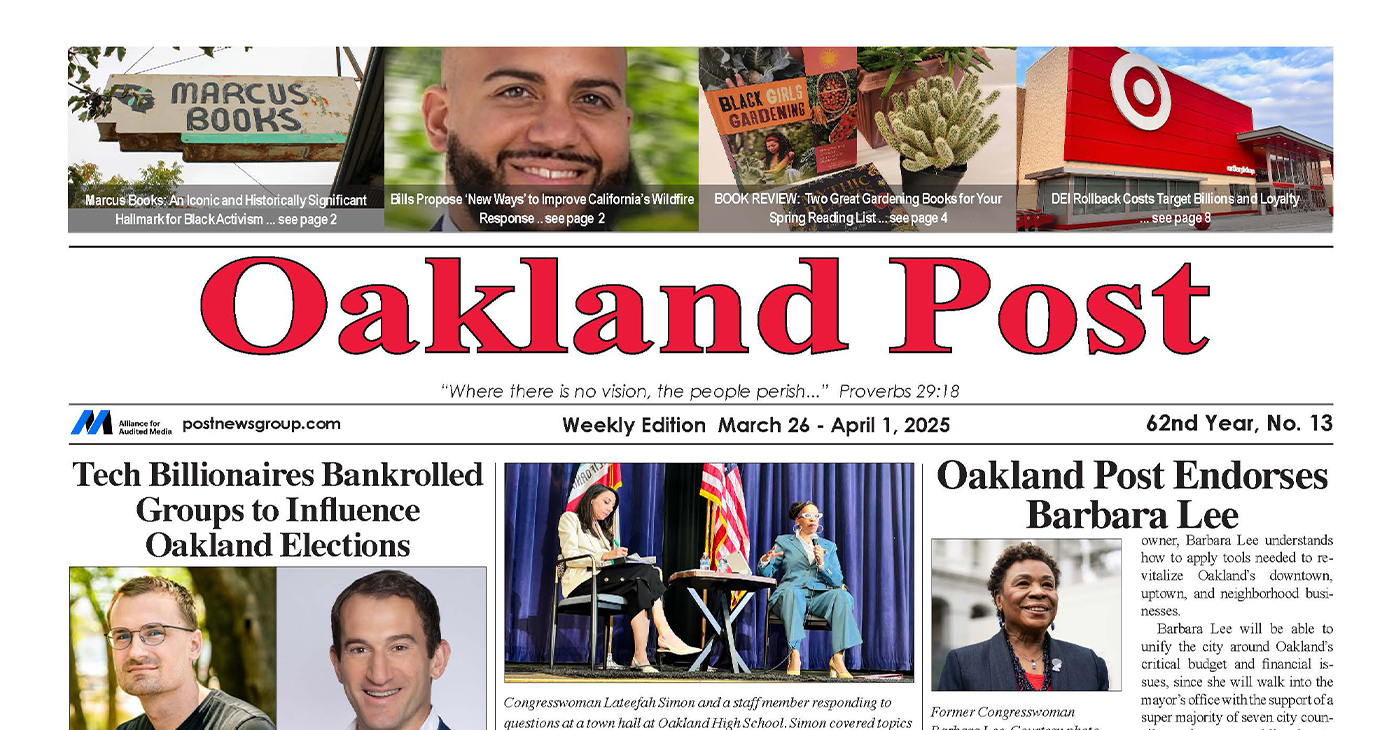Bay Area
Former Black Panther Party Headquarters Could Be Turned into Apartments
Fredrika Newton, widow of Black Panther Party founder Huey P. Newton, read a statement in support of the proposal at Monday’s meeting, noting that an agreement between the Huey P. Newton Foundation and Cloud ensured that the BPP’s history would be preserved there. “[We] believe the appropriate path forward is to support a Black and Oakland-owned redevelopment that will simultaneously welcome us to expanding our footprint at the site.”

By Brandon Patterson
The former North Oakland headquarters of the Black Panther Party could be converted into apartments under a new proposal from the building’s current owner, a plan that has drawn consternation from community members about the implications of tearing down the historic site while receiving mixed reactions from former members of the BPP.
Kim Cloud, who has owned the building since 1996 and currently runs a bakery out of it, is proposing to convert the building into a five-story, 20-unit apartment building and said at an online hearing of the Landmark Preservation Advisory board on Monday that his aim is to create more housing in Oakland.
He has the backing of Fredrika Newton, the widow of BPP co-founder Huey Newton. Yet, other former BBP members voiced concern at the meeting or to the media in the past week.
The advisory board voted to allow the proposal to go through the standard city review process on Monday, while requiring Cloud and his development partners to do a deeper historical analysis of the property than the one they presented at the meeting and develop added proposals for how to preserve BPP history at the site if their redevelopment plan gets approved by the city.
“The concerns I hear from the community and staff and folks on this board is that it’s just not quite there,” board member Chris Andrews said on Monday, referring to Cloud’s team’s preservation proposal.
The development plan made waves on social media last week after a picture of the notice of the plan posted in the window of Cloud’s bakery began circulating online. Commenters on Instagram raised concerns about the role of gentrification in bringing an end to the historic site, located at 5616-5626 Martin Luther King Jr. Way, and opponents of the plan voiced similar concerns at Monday’s hearing.
The proposal would create 18 units of market-rate housing while reserving just two units for low-income residents. And while the building has already been significantly altered since the days of the BPP, memorabilia commemorating the history of the site, including copies of the original BPP newspaper and the organization’s famous Ten Point plan, currently hang on the wall in the bakery.
Cloud has worked collaboratively with former BPP members to preserve the history of the party at the site. But a historical analysis conducted on behalf of his development team determined that the building itself does not qualify for historic preservation since the only current marker of the site’s history is the “impermanent” display of memorabilia on the bakery’s wall.
Fredrika Newton read a statement in support of the proposal at Monday’s meeting, noting that an agreement between the Huey P. Newton Foundation and Cloud ensured that the BPP’s history would be preserved there. “[We] believe the appropriate path forward is to support a Black and Oakland-owned redevelopment that will simultaneously welcome us to expanding our footprint at the site.”
But other former BPP members have expressed resistance. “Consulting us is the best thing, whether it’s yea or nay,” Katherine Campbell, who was active in the BPP in San Francisco and Oakland, told The Oaklandside, “We didn’t know if we were going to live to tell the story, but we did, and we’re here.”
Another former party member, Saturu Ned, raised concern about access to the new housing for low-income residents. “Someone has a right to look at what’s going to benefit them and their family,” said Ned, “but also we need to look at the community.”
“When we did housing, it was housing according to income.”
According to The Oaklandside, city planners said at the meeting that Oakland’s zoning manager would make the final decision, and the proposal will not come up for discussion again at other public meetings.
Activism
Oakland Post: Week of April 2 – 8, 2025
The printed Weekly Edition of the Oakland Post: Week of April 2 – 8, 2025

To enlarge your view of this issue, use the slider, magnifying glass icon or full page icon in the lower right corner of the browser window.
Activism
Oakland Post Endorses Barbara Lee
Barbara Lee will be able to unify the city around Oakland’s critical budget and financial issues, since she will walk into the mayor’s office with the support of a super majority of seven city council members — enabling her to achieve much-needed consensus on moving Oakland into a successful future.

As we end the celebration of Women’s History Month in Oakland, we endorse Barbara Lee, a woman of demonstrated historical significance. In our opinion, she has the best chance of uniting the city and achieving our needs for affordable housing, public safety, and fiscal accountability.
As a former small business owner, Barbara Lee understands how to apply tools needed to revitalize Oakland’s downtown, uptown, and neighborhood businesses.
Barbara Lee will be able to unify the city around Oakland’s critical budget and financial issues, since she will walk into the mayor’s office with the support of a super majority of seven city council members — enabling her to achieve much-needed consensus on moving Oakland into a successful future.
It is notable that many of those who fought politically on both sides of the recent recall election battles have now laid down their weapons and become brothers and sisters in support of Barbara Lee. The Oakland Post is pleased to join them.
Activism
Oakland Post: Week of March 28 – April 1, 2025
The printed Weekly Edition of the Oakland Post: Week of March 28 – April 1, 2025

To enlarge your view of this issue, use the slider, magnifying glass icon or full page icon in the lower right corner of the browser window.
-

 Activism3 weeks ago
Activism3 weeks agoWe Fought on Opposite Sides of the Sheng Thao Recall. Here’s Why We’re Uniting Behind Barbara Lee for Oakland Mayor
-

 Activism4 weeks ago
Activism4 weeks agoSan Francisco Is Investing Millions to Address Food Insecurity. Is Oakland Doing the Same?
-

 #NNPA BlackPress3 weeks ago
#NNPA BlackPress3 weeks agoRev. Dr. Jamal Bryant’s Black Church Target Boycott Mobilizes 150,000
-

 Activism3 weeks ago
Activism3 weeks agoFaith Leaders Back Barbara Lee for Mayor, Criticize Candidate Loren Taylor for Dishonest Campaigning
-

 Activism4 weeks ago
Activism4 weeks agoOakland Post: Week of March 12 – 18, 2025
-

 #NNPA BlackPress3 weeks ago
#NNPA BlackPress3 weeks agoRecently Approved Budget Plan Favors Wealthy, Slashes Aid to Low-Income Americans
-

 Activism3 weeks ago
Activism3 weeks agoGroup Takes First Steps to Recall District Attorney Diana Becton
-

 Activism2 weeks ago
Activism2 weeks agoOakland’s Most Vulnerable Neighborhoods Are Struggling to Eat and Stay Healthy



















































